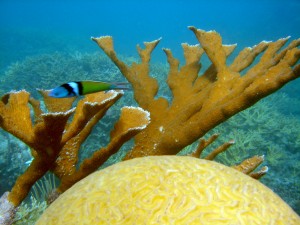
The region stretching from central Mexico to Costa Rica spans a continuum from one of the world’s largest mega-cities, through rural mestizo villages to remote indigenous communities, and from high-altitude deserts to lowland tropical rainforests and coral reefs. Diverse government and community responses to conservation challenges in Mesoamerica provide rich opportunities for integrative conservation research. ABS faculty are conducting research at three locations: Mexico’s eastern Sierra Madre, the eastern Yucatan Peninsula of Mexico, and the ridge-to reef system of coastal Belize (e.g. Heyman et al. 2005). Much of the current research is conducted by biologists on topics related to ecological functions and biodiversity. To achieve broader impacts for conservation in these areas, more social science research on communities and governance is needed.
Population growth and development have dramatically impacted Mesoamerica. For example, in the Riviera Maya, Quintana Roo, Mexico, human impacts include groundwater drawdown and contamination, and changes in river flow regimes. Recreational demands are inducing habitat modifications, species introductions, and growth of infrastructure leading to habitat decline and severed connections between habitat remnants. At the other end of the spectrum is the rural municipality of Calnali (population about 20,000) in the foothills of the eastern Sierra Madre, Mexico, populated by several primarily Nahua-speaking indigenous communities. The surrounding Huasteca region is biologically unique, with distinctive limestone topography and dozens of endemic species. The region is a prime candidate for ecotourism, but discharge of raw sewage into natural bodies of water has devastated many areas and created a health hazard for local people (Fisher et al., 2006). Firewood harvest, which destroys habitat and accelarates erosion, also threatens biodiversity in this region. Federal and local regulations prohibit both sewage discharge and unmanaged logging, but infrastructure and enforcement are lacking.
Turning to marine ecosystems, the Mesoamerican Reef (MAR), the second largest reef in the world, stretching 720 km along the western edge of the Caribbean. A World Heritage Site, the area provides critical habitat for rare and endangered species, such as whale sharks (Rhincodon typus), West Indian Manatee (Trichecus manatus manatus), American crocodile (Crocodylus acutus), hawksbill turtle (Eretmocheles imbricata), and green turtle (Chelonia mydas). This reef contributes significantly to the economies of Guatemala, Belize, Mexico and Honduras, primarily through tourism and fishing. Unfortunately, it is threatened by over fishing, unregulated tourism development, sedimentation, and widespread coral bleaching. Recognizing the values of the reef, the four countries launched the Mesoamerican Barrier Reef Initiative in 1997 to promote the conservation and sustainable use of the reef. The centerpiece of this program is a network of marine protected areas. The MAR provides an excellent opportunity to practice ABS through study of bleaching resistance, spawning aggregations, connectivity, and sustainability in a network of marine protected areas (Gibson et al. 2004).
Literature Cited:
Fisher, H.S., B. B. M. Wong, and G. G. Rosenthal 2006. Alteration of the chemical environment disrupts communication in a freshwater fish. Proceedings: Biological Sciences 273: 1187–1193.
Gibson, J., M. McField, W. Heyman, S. Wells, J. Carter, G. Sedberry. 2004. “Belize’s evolving system of marine reserves.” In J. Sobel and C. Dahlgren, eds. Marine Reserves: A Guide to Science, Design and Use. The Ocean Conservancy, Washington. D.C. pp 287-315.
Heyman, W.D., B. Kjerfve, K.L. Rhodes, R.T. Graham, and L. Garbutt. 2005. Cubera snapper, Lutjanus cyanopterus, spawning aggregations on the Belize Barrier Reef over a six year period. Journal of Fish Biology 67(1):83-101.

